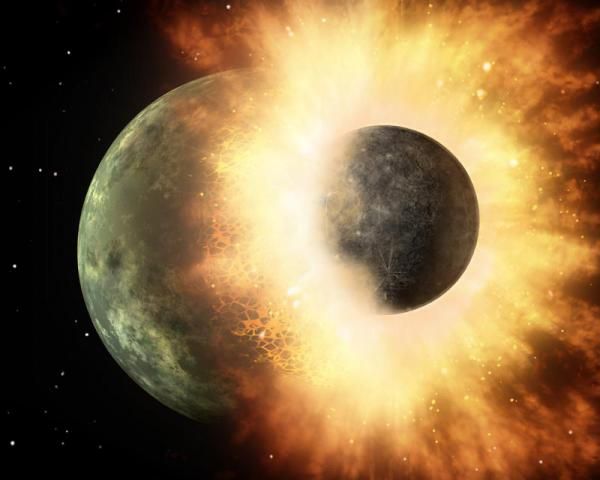
Pluto-sized Body Socked Early Earth

The Earth capped its birthday party with a bang, and left valuable party favors for its eventual human inhabitants a supply of precious elements such as gold and platinum, new research suggests.
Colossal collisions more than 4.5 billion years ago are believed to have formed the cores of the Earth, moon and Mars as well as the magma oceans that once covered them.
The collisions deposited elements that are highly attracted to iron, the main ingredient in the Earth's core, but curiously, the Earth's outer layers have a high concentration of them. Scientists have spent decades trying to explain this contradiction. New research suggests the reason is that a body the size of Pluto walloped the Earth during our planet's final round of formation. [Related: More on the crashes into moon, Mars.]
Massive impact
The projectile, which was about 1,500 to 2,000 miles wide (2,400 to 3,200 kilometers), dealt Earth the largest of the impacts during its late formation, suggests the study, which appears in the Dec. 10 edition of the journal Science. The Pluto-size body hit with enough force that it possibly changed how much the Earth tilts on its axis by 10 degrees.
A collision of that scope would be expected to deposit elements that are highly attracted to iron in the Earth's core, leaving the Earth's rocky crust and mantle the layer of hot but solid rock that flows below the planet's crust void of them. And if that were the case, gold would be a much more precious commodity today, said study team member Richard Walker, a geologist at the University of Maryland in College Park.
But because the Earth was in its final stages of formation, "anything that was added to it was splatted onto it" rather than locked deep within, Walker told OurAmazingPlanet. The iron-loving elements in the Pluto-size body were added to the outer parts of the Earth, leaving humans with an accessible supply of siderophiles, as these elements are called.
Sign up for the Live Science daily newsletter now
Get the world’s most fascinating discoveries delivered straight to your inbox.
Common collisions
Large impacts were common during the final stages of Earth's formation. The impact of a body about 30 times larger than the Pluto-size projectile created Earth's moon, Walker said. The predicted sizes of these late-arriving projectiles are within the realm of possible sizes of asteroids and fit computer models that demonstrate how Earth could have formed from a series of impacts.
To get an idea of how big the Pluto-sized body was, Walker said, it was about one-third of one percent of the mass of the Earth , which is also equal to one-third of the mass of the Moon. It wasn't the biggest collision ever, Walker said, but "getting hit with Pluto today would make for a very bad day."
- 7 Ways the Earth Changes in the Blink of an Eye
- Earth's Measurers Say U.S. Needs More Tools for Task
- Image Gallery: Deadly Earthquakes
Reach OurAmazingPlanet staff writer Brett Israel at bisrael@techmedianetwork.com. Follow him on Twitter @btisrael.












